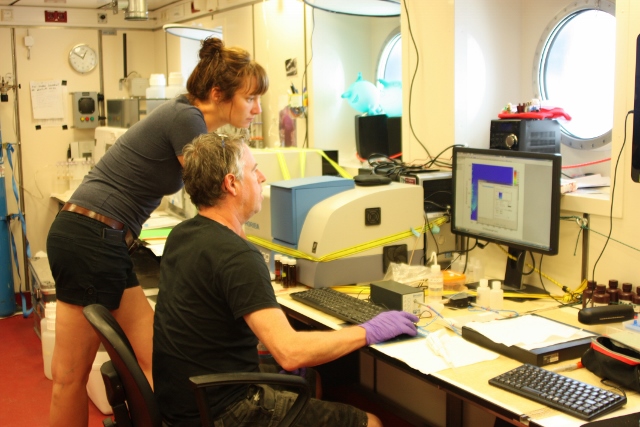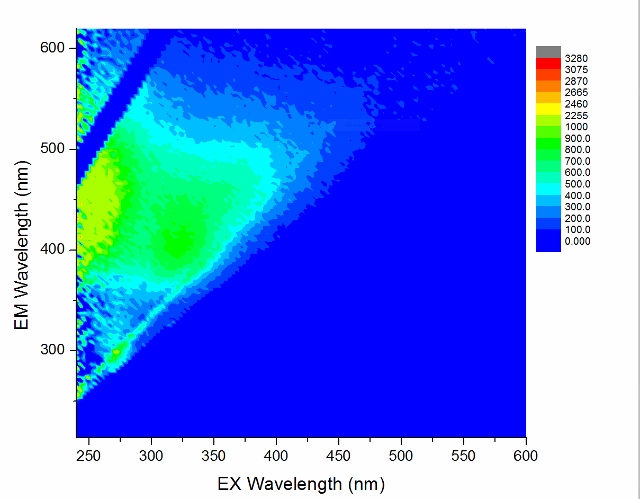Seitenpfad:
- Presse
- Ultrapac: Quer über den Pazifik
Ultrapac: Quer über den Pazifik
25.01.2016
Deep waters, coloured waters
Our scientists on board RV SONNE have left their (most probably) deepest station recently – at 30°S 140°W and with a depth of 5270 meters. They keep getting some really interesting results – seems like there’s lots of biotic action at depths around 150 to 200 meters. Some weather action is also coming up, though. You can find more details – mostly in German – in the Weekly Report published through the Control Station German research Vessels by Chief scientist Tim Ferdelman from our institute.
Meanwhile, Clara, Allan and Helena – this weeks personal reporters in board - tell us about the colour of the sea:
“If you've ever wondered why the sea is blue, the colour of the ocean is a result of the scattering and absorption of light. Pure water absorbs light in both the red and in the ultra violet (UV) spectral bands. As a result, mostly blue and some UV light penetrate into the water body. It is scattered and reflected back to the surface by the water molecules, thus we perceive the water to be blue. However, natural waters contain not only water molecules but also a cocktail of other light-absorbing compounds. The predominant light-absorbing substances are pigments, mainly chlorophyll used by microscopic phytoplankton for photosynthesis. Because of its optic properties, it is possible to quantify chlorophyll by remote sensing with satellites, and therefore monitor the distribution of phytoplankton in the oceans. However, there are other substances in the water besides planktonic chlorophyll that absorb light. These compounds are referred to as Coloured Dissolved Organic Matter (CDOM), or coloured detrital matter. CDOM primarily results from the breakdown of phytoplankton organisms. Various sources and sinks influence the concentration of this material in the sea. These include the cellular production of light absorbing proteins bellow the euphotic zone, which adds to the CDOM pool, and the photochemical alteration of CDOM in surface waters as a major sink.
On board our ship, Allan Grassie from the National University of Ireland in Galway studies the optical properties of CDOM in dry-lab I. The optical properties of CDOM play a crucial role in the underwater light budget. They determine the amount of light available to organisms. It is also important for measurements: Since CDOM absorbs light in similar spectral regions as chlorophyll, it can potentially interfere with remote sensing measurements. Allan measures CDOM absorption. First, he filters seawater collected at multiple depths in order to remove all larger particles. A subsample of this filtrate is then analysed in a spectrofluorometer, which exposes the sample to artificial light at various wavelengths. The instrument measures the absorbance and fluorescence of the sample. CDOM is present at very low concentrations in the South Pacific Gyre, but it is still possible to detect and characterise its composition and to infer its relative concentration. Since CDOM can absorb blue to ultra-violet light, its concentration can influence the colour of the sea by turning it green to brown. The concentration of CDOM also determines the light penetration depth. However, here in the South Pacific, CDOM concentrations are so low that water is of a deep blue colour, and light reaches depths of up to 200 m.
Most CDOM in the deep ocean is rather stable if not exposed to light, it’s called refractory. Thus, it can help to trace the origin of water masses. To test the effects of light on deep refractory CDOM, Allan set up a photo-bleaching experiment on board together with Helena Osterholz from the University of Oldenburg. Helena will look at changes in DOM composition using another tool, the ultrahigh resolution mass spectrometry via a Fourier-Transform Ion Cyclotron Resonance Mass Spectrometer. The instrument, however, is as heavy as the name is long, and analyses have to wait until the arrival of the samples in the home lab. Meanwhile, old waters from the deep are exposed to direct sunlight on the ship’s deck and the bleaching of CDOM monitored over time. Already, the effects of UV are visible. Let’s see how it continues until our arrival in Wellington.”
Written by:
Clara Martinez Perez
Allan Grassie
Helena Osterholz
Our scientists on board RV SONNE have left their (most probably) deepest station recently – at 30°S 140°W and with a depth of 5270 meters. They keep getting some really interesting results – seems like there’s lots of biotic action at depths around 150 to 200 meters. Some weather action is also coming up, though. You can find more details – mostly in German – in the Weekly Report published through the Control Station German research Vessels by Chief scientist Tim Ferdelman from our institute.
Meanwhile, Clara, Allan and Helena – this weeks personal reporters in board - tell us about the colour of the sea:
“If you've ever wondered why the sea is blue, the colour of the ocean is a result of the scattering and absorption of light. Pure water absorbs light in both the red and in the ultra violet (UV) spectral bands. As a result, mostly blue and some UV light penetrate into the water body. It is scattered and reflected back to the surface by the water molecules, thus we perceive the water to be blue. However, natural waters contain not only water molecules but also a cocktail of other light-absorbing compounds. The predominant light-absorbing substances are pigments, mainly chlorophyll used by microscopic phytoplankton for photosynthesis. Because of its optic properties, it is possible to quantify chlorophyll by remote sensing with satellites, and therefore monitor the distribution of phytoplankton in the oceans. However, there are other substances in the water besides planktonic chlorophyll that absorb light. These compounds are referred to as Coloured Dissolved Organic Matter (CDOM), or coloured detrital matter. CDOM primarily results from the breakdown of phytoplankton organisms. Various sources and sinks influence the concentration of this material in the sea. These include the cellular production of light absorbing proteins bellow the euphotic zone, which adds to the CDOM pool, and the photochemical alteration of CDOM in surface waters as a major sink.
On board our ship, Allan Grassie from the National University of Ireland in Galway studies the optical properties of CDOM in dry-lab I. The optical properties of CDOM play a crucial role in the underwater light budget. They determine the amount of light available to organisms. It is also important for measurements: Since CDOM absorbs light in similar spectral regions as chlorophyll, it can potentially interfere with remote sensing measurements. Allan measures CDOM absorption. First, he filters seawater collected at multiple depths in order to remove all larger particles. A subsample of this filtrate is then analysed in a spectrofluorometer, which exposes the sample to artificial light at various wavelengths. The instrument measures the absorbance and fluorescence of the sample. CDOM is present at very low concentrations in the South Pacific Gyre, but it is still possible to detect and characterise its composition and to infer its relative concentration. Since CDOM can absorb blue to ultra-violet light, its concentration can influence the colour of the sea by turning it green to brown. The concentration of CDOM also determines the light penetration depth. However, here in the South Pacific, CDOM concentrations are so low that water is of a deep blue colour, and light reaches depths of up to 200 m.
Most CDOM in the deep ocean is rather stable if not exposed to light, it’s called refractory. Thus, it can help to trace the origin of water masses. To test the effects of light on deep refractory CDOM, Allan set up a photo-bleaching experiment on board together with Helena Osterholz from the University of Oldenburg. Helena will look at changes in DOM composition using another tool, the ultrahigh resolution mass spectrometry via a Fourier-Transform Ion Cyclotron Resonance Mass Spectrometer. The instrument, however, is as heavy as the name is long, and analyses have to wait until the arrival of the samples in the home lab. Meanwhile, old waters from the deep are exposed to direct sunlight on the ship’s deck and the bleaching of CDOM monitored over time. Already, the effects of UV are visible. Let’s see how it continues until our arrival in Wellington.”
Written by:
Clara Martinez Perez
Allan Grassie
Helena Osterholz
Last reported position of RV SONNE:
S 39°48'
W 174°06'

Want to learn more about the cruise? Watch our video. Sorry, in German only.
Want to learn more about ocean colour? Check out NASA's site!
Want to know where the RV Sonne is?
Click here.
Click here.
